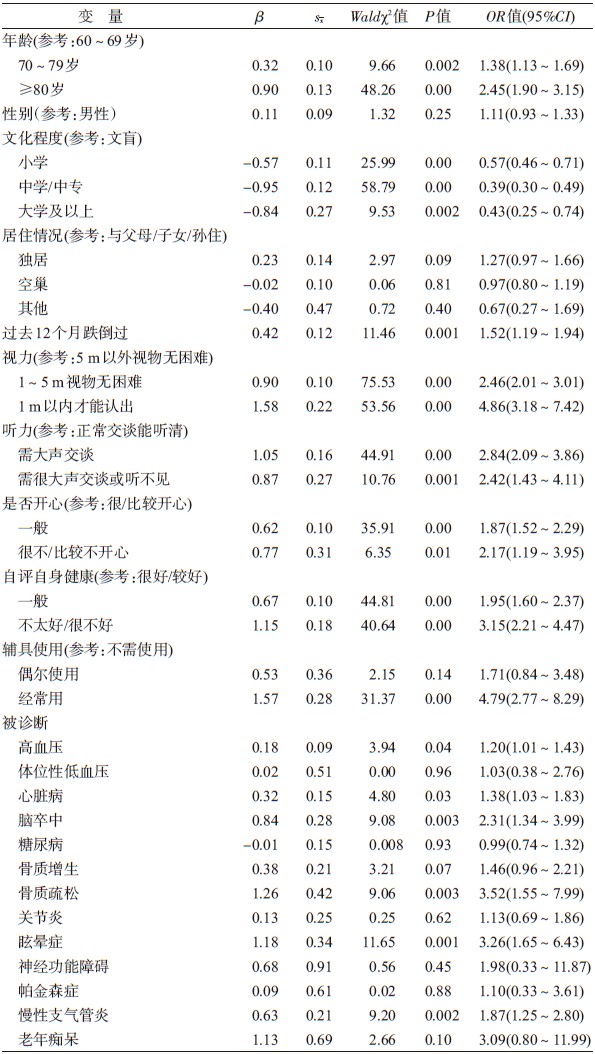文章信息
- 王浩, 赵鸣, 段蕾蕾, 许坚, 何勇, 罗央努, 孙军, 胡如英, 方乐, 耳玉亮, 俞敏. 2014.
- Wang Hao, Zhao Ming, Duan Leilei, Xu Jian, He Yong, Luo Yangnu, Sun Jun, Hu Ruying, Fang Le, Er Yuliang, Yu Min. 2014.
- 浙江省城乡社区60岁以上老年人害怕跌倒而减少活动的流行特征及影响因素分析
- Analysis on the characteristics and factors associated with avoidance of activity induced by fear of falling in the community-dwelling elderly
- 中华流行病学杂志, 2015, 36(8): 794-798
- Chinese Journal of Epidemiology, 2015, 36(8): 794-798
- http://dx.doi.org/10.3760/cma.j.issn.0254-6450.2015.08.005
-
文章历史
- 投稿日期:2015-01-09
2. 中国疾病预防控制中心慢性非传染性疾病预防控制中心;
3. 慈溪市疾病预防控制中心;
4. 富阳市疾病预防控制中心
2. National Center for Chronic and Noncommunicable Disease Control and Prevention, Chinese Center for Disease Control and Prevention;
3. Cixi Municipal Center for Disease Control and Prevention;
4. Fuyang Municipal Center for Disease Control and Prevention
跌倒在我国>65岁老年人伤害死因顺位中居于首位[1]。老年人跌倒发生率高,后果严重,是老年人伤残和死亡的主要影响因素[2]。跌伤是医院急诊救治最常见的伤害类型并有很高的疾病负担[3, 4]。害怕跌倒(fear of falling)是指在进行某种活动时为了避免跌倒而出现的自我效能或信心降低。老年人因害怕跌倒而减少活动(avoidance of activity)导致其机体功能减退、社会不适应、生活质量降低以及跌倒风险增加,是值得关注的健康问题[5, 6, 7, 8]。本文旨在了解社区老年人害怕跌倒而减少活动的流行特征及其影响因素,为预防老年性跌倒及提高其生活质量提供依据。
对象与方法1. 调查对象:2013年10-12月选择浙江省慈溪市(城市)和富阳市(农村)为调查点。每个调查点随机抽取2个乡镇街道(慈溪市抽取古塘和浒山街道,富阳市抽取东洲街道和龙门镇),每个乡镇街道随机选取1个村/居委会,每个村/居委会整群抽取500名>60岁本地户籍老年人作为调查对象。对于认知障碍及无法正常沟通顺利完成问卷者,由其家人/监护人通过回忆代答完成(可不作答问卷中知识和态度的问题)。
2. 调查方法:由经过统一培训的调查员入户采用自行设计问卷面对面调查。问卷内容包括一般情况(出生年月、性别、文化程度、居住情况)、跌倒发生情况(过去12个月是否发生过跌倒,以及跌倒发生时间、地点、受伤时活动、跌倒高度、主要自身/环境因素、受伤部位、伤害性质、严重程度、接受何种处理和结局等)、疾病患病情况(是否被诊断患有高血压、体位性低血压、心脏病、脑卒中、糖尿病、骨质增生、骨质疏松、关节炎、老年痴呆、慢性支气管炎等慢性病及其诊断时间)、视力和听力情况、拐杖/助步器等辅具使用情况、跌倒相关知识/态度等。
3. 统计学分析:采用EpiData 3.1软件数据录入和逻辑核查。数据统计分析采用SPSS 18.0软件,率的比较采用χ2检验。多因素分析采用非条件logistic回归(α入=0.05,α出=0.1)。用逐步后退法建立回归方程。因变量通过问题“是否害怕跌倒而减少活动?”获得(0=否,1=是)。入选变量赋值:将性别(1=男,2=女)、年龄(1=60~69岁、2=70~79岁、3=≥80岁)、文化程度(1=文盲、2=小学、3=中学/中专、4=大学及以上)、居住情况(1=与父母/子女/(外)孙住、2=独居、3=空巢、4=其他)、过去12个月发生过跌倒(0=无、1=是)、拐杖/助步器等辅具使用(0=从不用、1=偶尔用、2=经常/总是用)、视力情况(1=5 m以外视物无困难、2=相距1~5 m视物无困难、3=1 m以内才能认出)、听力情况(1=正常交谈能听清、2=需大声交谈才行、3=需很大声交谈或听不见)、过去12个月是否开心(1=很/比较开心、2=一般、3=很/比较不开心)、自评自身健康状况(1=很好/较好、2=一般、3=不太好/很不好)、是否被医生诊断高血压、体位性低血压、心脏病、脑卒中、糖尿病、骨质增生、骨质疏松、关节炎、眩晕症、老年痴呆、慢性支气管炎等疾病(0=否、1=是)作为自变量。
结 果1. 基本情况:共调查2 065人,其中2 006人参加调查,59人拒绝调查,应答率为97.14%,城乡人群应答率分别为96.07%和98.24%。因34人未作答“是否害怕跌倒而减少活动”问题,故最终1 972人纳入分析,其中男性926人(46.95%),女性1 046人(53.05%)。调查对象平均年龄为(70.66±7.81)岁。调查对象中因害怕跌倒而减少活动的比例为43.15%(95%CI:40.97%~45.34%),其中男性和女性分别为41.79%(95%CI:38.61%~44.98%)和44.36%(95%CI:41.34%~47.38%),性别间差异无统计学意义(χ2=1.32,P>0.05)。60~69岁、70~79岁及≥80岁年龄组因害怕跌倒而减少活动的比例分别为37.07%、44.87%和59.04%,随着年龄增加,调查对象中因害怕跌倒而减少活动的比例不断增加(趋势χ2=48.93,P<0.01)。过去12个月曾经发生过跌倒的调查对象中,因害怕跌倒而减少活动的比例为51.94%(95%CI:46.34%~57.53%),未曾发生过跌倒者比例为41.52%(95%CI:39.14%~43.89%),差异有统计学意义(χ2=11.56,P<0.01)。
2. 老年人害怕跌倒而减少活动的影响因素分析:
(1)单因素分析:应用单因素logistic回归方法分析23个相关因素,初筛出14个可疑影响因素,其余因素差异无统计学意义(表 1)。
(2)多因素分析:选取单因素分析有意义的14个因素进行多因素非条件logistic逐步回归分析。结果显示,自评健康状况一般(OR=1.53)或不好(OR=1.69)、视力不良(相距1~5 m视物无困难:OR=1.95,1 m以内才能认出:OR=2.98)、听力不良(需大声交谈:OR=1.77)、经常使用辅具(OR=2.71)、年龄≥80岁(OR=1.56)、被诊断骨质疏松(OR=3.35)、被诊断眩晕症(OR=3.05)是老年人因害怕跌倒而减少活动的可疑危险因素,而文化程度高(大学及以上:OR=0.54,中学/中专:OR=0.54,小学:OR=0.74)是保护因素(表 2)。
我国少有老年人因害怕跌倒而减少活动的文献报道。国外文献报道老年人因害怕跌倒而减少活动的比例为15%~55%[7, 9, 10, 11, 12, 13, 14]。其中荷兰一项对4 031名≥70岁老年人的调查结果该比例为37.9%;Jane等对美国北卡罗莱纳州农村社区663名≥50岁老年人调查的比例为35.7%。本次调查该比例为43.15%,均高于上述国外两次调查。
国外多数文献报道,女性害怕跌倒比例高于男性[15, 16, 17]。其原因可解释为老年女性跌倒发生率高于老年男性,而跌倒经历会导致女性产生害怕跌倒的心理;其次女性对自身健康较男性更关注,对机体疼痛更恐惧[18]。Zijlstra等[7]研究发现,女性因害怕跌倒而减少活动的比例也同样高于男性。本次调查发现女性害怕跌倒而减少活动略高于男性(44.36% vs. 41.79%),但差异无统计学意义,其原因有待于深入分析。随着年龄增加,老年人中害怕跌倒而减少活动的比例逐渐增加,与文献报道结果一致[7]。文化程度高是否为老年人害怕跌倒而减少活动的保护因素,文献报道结果不一[7, 17]。本文发现文化程度高的老年人因害怕跌倒而减少活动的比例低。
Arfken等[19]和Li等[20]发现,老年人越是害怕跌倒,其跌倒次数越多。Friedman等[13]对美国2 212名65~84岁社区老年人进行20个月随访观察,发现基线调查时有跌倒史是老年人日后产生害怕跌倒的独立预测因子(OR=1.75),而基线调查时害怕跌倒也是日后老年人发生跌倒的独立预测因子(OR=1.79),所以害怕跌倒与跌倒发生互为因果,形成恶性循环。本次调查发现,经常使用拐杖/助步器等辅具老年人发生害怕跌倒而减少活动是不使用辅具老年人的2.7倍,这可能与老年人害怕跌倒才使用辅具有关,与其他文献报道一致[6, 21]。与自评健康状况好的老年人相比,自评健康一般/差的老年人更容易因害怕跌倒而减少活动,亦同于其他文献报道[7]。
值得需要注意,老年人被诊断为骨质疏松后因害怕跌倒而减少活动的风险是其他老年人年3.35倍。运动对骨骼产生应力效应会激活骨重建,刺激成骨细胞,抑制破骨细胞[22]。同时户外运动还能增加体内维生素D浓度,促进钙吸收和骨骼形成。运动能改善骨质疏松患者的生活质量[23]。因此骨质疏松老年人在加强营养的同时,医务工作者应鼓励其加强运动。同时运动应量力而行,循序渐进,避免运动过程中发生伤害。此外国外文献报道,低家庭收入[24]、抑郁[16,25 -26]、认知功能损伤[25]、肥胖[24, 25]等因素也与老年人害怕跌倒发生有关,但本次调查中未纳入这些因素。
本文存在局限性。首先横断面研究无法在自变量和因变量之间推测因果关系,logistic回归模型只能用于解释因变量和自变量之间的关系。其次,调查对象为老年人,回忆过去12个月跌倒发生情况,可能存在回忆偏倚。
| [1] Qin ZH, Yu PL, Wu ZL. Current situation and research progress of falls in the elderly [J]. Chin J Geriatr, 2005, 24(9):711-714. (in Chinese) 覃朝晖, 于普林, 乌正赉. 老年人跌倒研究的现状及进展[J]. 中华老年医学杂志, 2005, 24(9):711-714. |
| [2] Qin ZH, Yu PL, Zhu XP, et al. Study on risk factors for falls in an elderly community in Chongwen district of Beijing [J]. Chin J Epidemiol, 2006, 27(7):579-582. (in Chinese) 覃朝晖, 于普林, 朱晓平, 等. 北京市城市社区1 512名老年人跌倒的危险因素分析[J].中华流行病学杂志, 2006, 27(7):579-582. |
| [3] Zhang XW, Xiao YY, Pan J, et al. Sentinel surveillance of injury in emergency departments in hospitals in Zhejiang province, 2009-2010 [J]. Dis Surveill, 2012, 27(3):221-225. (in Chinese) 张新卫, 肖媛媛, 潘劲, 等. 2009-2010年浙江省28家哨点医院急诊室伤害监测结果分析[J]. 疾病监测, 2012, 27(3):221-225. |
| [4] Li LT, Wang SY. Disease burden and risk factors of falling among the elderly [J]. Chin J Epidemiol, 2001, 22(4):262-264. (in Chinese) |
| [5] Gagnon N, Flint AJ, Naglie G, et al. Affective correlates of fear of falling in elderly persons [J]. Am J Geriatr Psychiatry, 2005, 13(1):7-14. |
| [6] Scheffer AC, Schuurmans MJ, van Dijk N, et al. Fear of falling:measurement strategy, prevalence, risk factors and consequences among older persons [J]. Age Ageing, 2008, 37(1):19-24. |
| [7] Zijlstra GA, van Haastregt JC, van Eijk JT, et al. Prevalence and correlates of fear of falling, and associated avoidance of activity in the general population of community-living older people [J]. Age Ageing, 2007, 36(3):304-309. |
| [8] Tinetti ME, Powell L. Fear of falling and low self-efficacy:a case of dependence in elderly persons [J]. J Geronol, 1993, 48:35-38. |
| [9] Tinetti ME, Speechley M, Ginter SF. Risk factors for falls among elderly persons living in the community [J]. N Engl J Med, 1988, 319(26):1701-1707. |
| [10] Fletcher PC, Hirdes JP. Restriction in activity associated with fear of falling among community-based seniors using home care services [J]. Age Ageing, 2004, 33(3):273-279. |
| [11] Howland J, Peterson EW, Levin WC, et al. Fear of falling among the community-dwelling elderly [J]. J Aging Health, 1993, 5(2):229-243. |
| [12] Wilson MM, Miller DK, Andresen EM, et al. Fear of falling and related activity restriction among middle-aged African Americans [J]. J Gerontol A Biol Sci Med Sci, 2005, 60(3):355-360. |
| [13] Friedman SM, Munoz B, West SK, et al. Falls and fear of falling:which comes first? A longitudinal prediction model suggests strategies for primary and secondary prevention[J]. J Am Geriatr Soc, 2002, 50(8):1329-1335. |
| [14] Painter JA, Elliott SJ, Hudson S. Falls in community-dwelling adults aged 50 year and older:prevalence and contributing factors [J]. J Allied Health, 2009, 38(4):201-207. |
| [15] Chang NT, Chi LY, Yang NP, et al. The impact of falls and fear of falling on health-related quality of life in Taiwanese elderly [J]. J Community Health Nurs, 2010, 27(2):84-95. |
| [16] Chu CL, Liang CK, Chow PC, et al. Fear of falling (FF):Psychosocial and physical factors among institutionalized older Chinese men in Taiwan [J]. Arch Gerontol Geriatr, 2011, 53(2):e232-236. |
| [17] Martinez IP, Bravo BN, Pretel FA, et al. Fear of falling in elderly community-dwelling individuals [J]. Gac Sanit, 2010, 24(6):453-459. |
| [18] Shin YA, Park SU, Lee SU. Relationships between falls experience, exercise habit, fear of falling and physical fitness in elderly population [J]. J Korea Sport Res, 2006, 17(1):73-82. |
| [19] Arfken CL, Lach HW, Birge SJ, et al. The prevalence and correlates of fear of falling in elderly persons living in the community [J]. Am J Public Health, 1994, 84(4):565-570. |
| [20] Li F, Fisher KJ, Harmer P, et al. Fear of falling in elderly persons:association with falls, functional ability, and quality of life[J]. J Gerontol B Psychol Sci Soc Sci, 2003, 58(5):283-290. |
| [21] Sharaf AY. Ibrahim HS. Physical and psychosocial correlates of fear of falling:among older adults in assisted living facilities [J]. J Gerontol Nurs, 2008, 34(12):27-35. |
| [22] Liu XQ, Chen YP. Adcances in the study on physical activity in the prevention of primary osteoporosis[J]. J Nurs Sci, 2004, 19(16):79-80. (in Chinese) 刘雪琴, 陈玉平. 运动预防原发性骨质疏松症的研究进展[J]. 护理学杂志:综合版, 2004, 19(16):79-80. |
| [23] Shi D, Shi X, Li FL, et al. Clinical effect of exercise therapy on the patients with osteoporosis[J]. Chin J Geriatr, 2013, 32(8):872-874. (in Chinese) 施丹, 史晓, 李富龙, 等. 运动疗法对股指疏松症患者的临床作用研究[J]. 中华老年医学杂志, 2013, 32(8):872-874. |
| [24] Kumar A, Carpenter H, Morris R, et al. Which factors are associated with fear of falling in community-dwelling older people?[J]. Age Ageing, 2014, 43(1):76-84. |
| [25] Austin N, Devine A, Dick I, et al. Fear of falling in older women:a longitudinal study of incidence, persistence, and predictors [J]. J Am Geriatr Soc, 2007, 55(10):1598-1603. |
| [26] Dias RC, Freire MT, Santos EG, et al. Characteristics associated with activity restriction induced by fear of falling in community-dwelling elderly [J]. Rev Bras Fisioter, 2011, 15(5):406-413. |
 2015, Vol. 36
2015, Vol. 36




